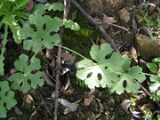
Taw Manroot
Encyclopedia
Marah watsonii, the Taw Manroot, is an uncommon manroot
endemic to central northern California
. Its range is bounded by the eastern coastal foothills, the western foothills of the northern Sierra Nevada and Cascades ranges and from Lake Berryessa
in the south to Lake Shasta in the north.
pieces.
Vines emerge from a large, hard tuberous root which can reach several meters in length and weigh in excess of 100 kilograms (220.5 lb). Newly exposed tubers can be seen along road-cuts or eroded slopes and have a scaly, tan-colored surface. Injured or decaying tubers take on a golden or orange color.
, that is, individual flowers are either male or female, but both sexes can be found on the same plant. Male flowers appear in open spikes while females flowers, distinguished by a swollen base, usually appear individually and hang down from the axis of the male flower-spike. The plant is self-fertile, i.e. pollen from the male flowers can fertilize the female flowers on the same plant; pollination is by insect
s.
Manroot
The manroots, wild cucumbers, or cucumber gourd are flowering plants in the gourd family , native to western North America. They are also commonly called Old man in the ground. The genus name comes from Hebrew מָרָ֔א The manroots, wild cucumbers, or cucumber gourd (genus Marah) are flowering...
endemic to central northern California
California
California is a state located on the West Coast of the United States. It is by far the most populous U.S. state, and the third-largest by land area...
. Its range is bounded by the eastern coastal foothills, the western foothills of the northern Sierra Nevada and Cascades ranges and from Lake Berryessa
Lake Berryessa
Lake Berryessa is the largest lake in Napa County, California. This reservoir is formed by the Monticello Dam, which provides water and hydroelectricity to the North Bay region of the San Francisco Bay Area....
in the south to Lake Shasta in the north.
Foliage
Taw manroot shares with all marah species non-twining stems and tendrils. Unlike other manroot species, however, Marah watsonii vines are nearly hairless with a glaucous, grey-green color. Vines appear in late winter or early spring in response to increased rainfall, and can climb or scramble to a length of 6 metres (19.7 ft). Unlike the leaves of other manroot species, taw manroot leaves are highly dissected and multi-lobed - reminiscent of jigsaw puzzleJigsaw puzzle
A jigsaw puzzle is a tiling puzzle that requires the assembly of numerous small, often oddly shaped, interlocking and tessellating pieces.Each piece usually has a small part of a picture on it; when complete, a jigsaw puzzle produces a complete picture...
pieces.
Vines emerge from a large, hard tuberous root which can reach several meters in length and weigh in excess of 100 kilograms (220.5 lb). Newly exposed tubers can be seen along road-cuts or eroded slopes and have a scaly, tan-colored surface. Injured or decaying tubers take on a golden or orange color.
Flower
Flowers are white. Flowers appear soon after the vine emerges. The flowers are monoeciousPlant sexuality
Plant sexuality covers the wide variety of sexual reproduction systems found across the plant kingdom. This article describes morphological aspects of sexual reproduction of plants....
, that is, individual flowers are either male or female, but both sexes can be found on the same plant. Male flowers appear in open spikes while females flowers, distinguished by a swollen base, usually appear individually and hang down from the axis of the male flower-spike. The plant is self-fertile, i.e. pollen from the male flowers can fertilize the female flowers on the same plant; pollination is by insect
Insect
Insects are a class of living creatures within the arthropods that have a chitinous exoskeleton, a three-part body , three pairs of jointed legs, compound eyes, and two antennae...
s.

